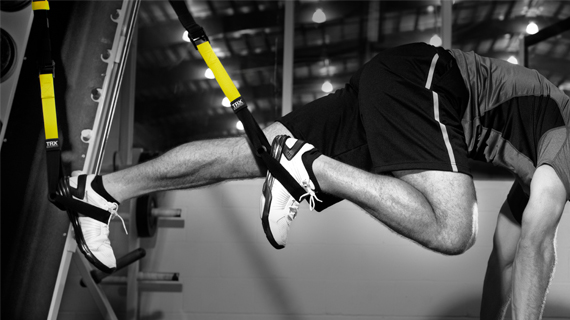10.12.14
Since its inception, TRX has advocated that people stand up to train. Going to a gym to sit down in a machine to “workout” after a day spent seated—during a commute, at the office, at the dinner table and while watching TV—creates dysfunctional bodies and can breed bad health. Exercising on the Suspension Trainer forces the trainee to use core strength to stabilize the body. Every movement executed on the TRX, from the TRX Biceps Curl to the TRX Side Plank, taxes the entire system as an interconnected series of kinetic chains, just as the body moves in sport and in life.
It’s old news that sitting is bad for you, but the rest of the world is starting to catch up with the TRX way of thinking. The New York Times’ Olivia Judson penned a piece for that publication’s Opinionator blog looking at recent studies about the health impact of sitting all day.
TRX has researched how long the average person spends sitting each day and includes this information in our Suspension Training Course manual. Before we examine Judson’s story, the response to it on the web and possible solutions to sit-“itis” (hint: it weighs less than two pounds, stuffs into its own small carry bag and can be used virtually anywhere), let’s take a look at the facts about how long the average American spends sitting every day:
• Average commute time: 1 hour (30 min each way)
• Average work day: 8 to 10 hours
• Average lunch time: 30 minutes to 1 hour
• Average dinner time: 30 minutes
• Average time spent watching TV: 4.75 hours
• Average amount of sleep: 7 hours
TOTAL HOURS SPENT SITTING: approximately 21+ hours
Now onto Judson’s piece, which she opens with this startling statement: “Your chair is your enemy. It doesn’t matter if you go running every morning, or you’re a regular at the gym. If you spend most of the rest of the day sitting — in your car, your office chair, on your sofa at home — you are putting yourself at increased risk of obesity, diabetes, heart disease, a variety of cancers and an early death. In other words, irrespective of whether you exercise vigorously, sitting for long periods is bad for you.” She then goes on to highlight numerous studies supporting these claims including, “Sitting time and mortality from all causes, cardiovascular disease and cancer.”
Judson’s story caught fire in the blogosphere and was featured in a number of prominent web publications including lifehaker a site dedicated to DIY tips for work, computing and living that has long advocated stand-up work spaces. In Judson’s piece, she points to several possible cures for the sitting ailment including standing desks equipped with treadmills so workers can walk at a low speed while mousing, typing and fielding calls.
That might be one fix, but Opinionator commenters noted that it’s an expensive and impractical solution that most workers will struggle to realize in this challenging economy. As Laura M. from Tucson, Arizona wrote, “I have heard this advice before. But really, who on earth can go to their boss with this proposal and actually be taken seriously??” Sarah from Washington, DC agreed, quipping, “Unless there is going to be a change in how the workplace is in America—and let’s be honest, it doesn’t look like that will happen anytime soon—this is just unhelpful and upsetting.”
If you walk into the TRX headquarters in San Francisco, one of the first things you’ll notice is everyone sitting on stability balls, even in meetings in the conference rooms. Sitting on stability balls requires core engagement and good posture. It also gives you an excellent stretching tool as evident by the habits of some TRX employees who are known to go into back bends over balls or stretch their hamstrings, mid meeting.
While it’s not instantly comfortable to spend a day balancing your bottom on a stability ball and takes some “training” to get used to versus slouching in a conventional chair, it’s one easy, affordable step any company could take to ease some of the pain and bad health that comes with a normal chair-bound life. It’s also a solution within reach of anyone, including the disgruntled NY Times commenters who could easily drop a few bucks to buy a stability ball and swap it out for their work chairs.
Then there’s the TRX option. Bring your Suspension Trainer with you to work and take regular breaks to stand up, stretch and hit a few reps of Suspension Training movements. Lest you get swept up in the rapids of your day, set the alarm on an auto countdown timer like the Gym Boss to go off every 20 to 30 minutes to remind you to get out of your chair and onto your TRX. This will help to program your body for functional movement, lubricate your joints and fire up your core stabilisers to help promote good posture and good health. The TRX Essentials: Flexibility DVD and the TRX Biomechanics: Healthy Back DVD both include exercises ideally suited to relieving sit-“itis.”
At lunch, you could do what employees at TRX do and undertake a full Suspension Training or Rip Training workout. If that’s not possible or feasible, carve out five or 10 minutes from your lunch break to get a core strengthening, metabolic blast on the TRX hitting a circuit of movements that include a pushing pattern (like a TRX Chest Press), a pulling pattern (like a TRX Low Row), a core strength exercise (like the TRX High Rotation) and a squat pattern (like the TRX Squat). Do it! Your body will thank you.

